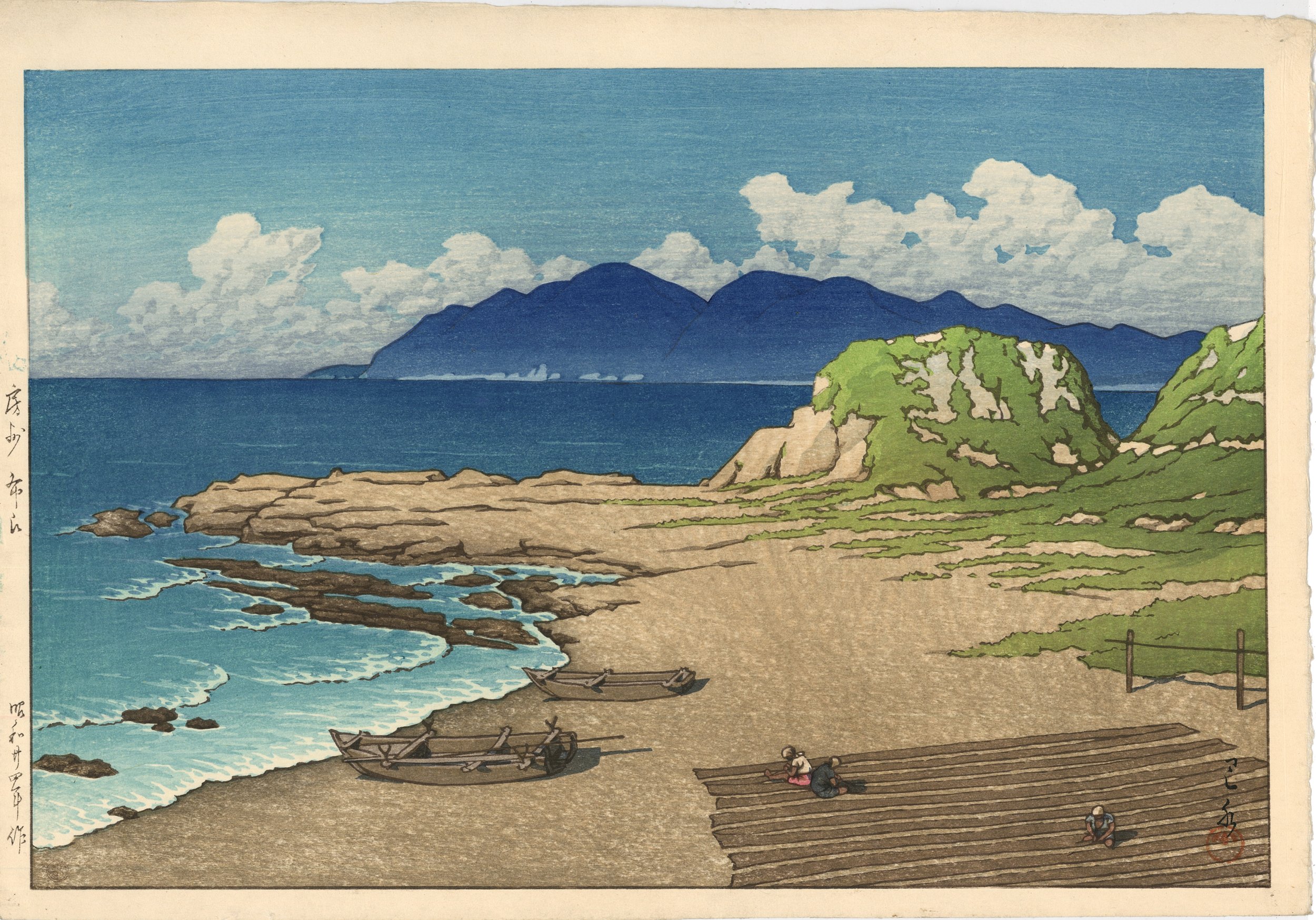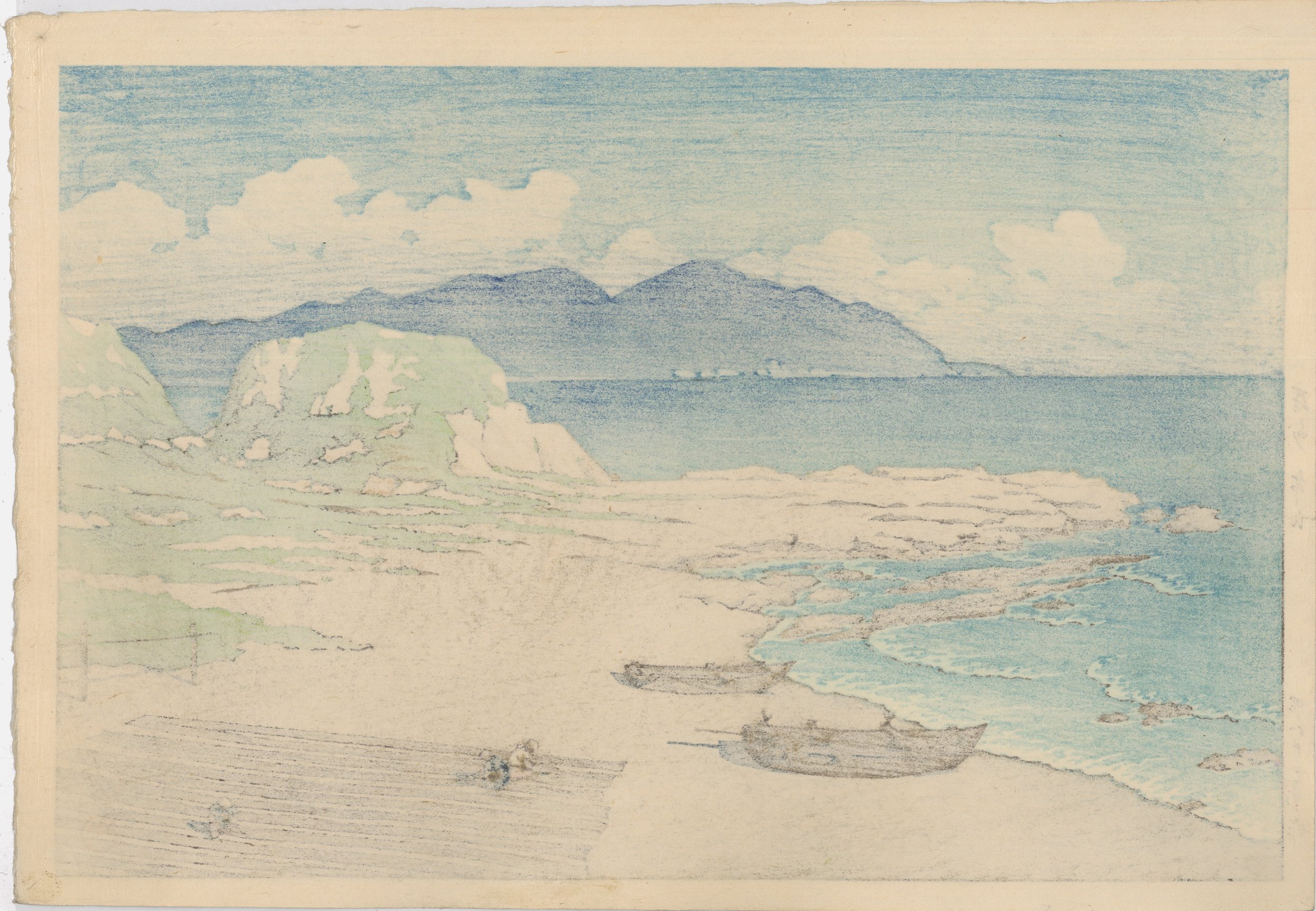Hasui | Mera, Boshu
川瀨巴水 Kawase Hasui ( 1883–1957)
房州布良
Mera, Boshu
1949
木版画 | 横绘大大判 | 27 × 39cm
Woodblock-print | Large Oban yoke -e | 27 × 39cm
初摺;品相近完美
First edition; fine condition
$4,500
在而今关东的房总半岛最南端,曾有着一个名为布良的小渔村,1949年8月底,步履不停的旅情诗人巴水到访此地。
从本作依山傍海的地理风貌可以看出,巴水当年作画的准确地点应该是现今的阿由户滨。湛蓝的晴空,翻腾的流云,连绵的群山,辽阔的海面以及曲折的海岸线在画中一层层堆叠分布,为全作奠定了和谐且富有韵律感的基调。盛夏的日光将砂岩晒得泛白,两条小木舟静静地停泊在浪花前听着涛声。沙滩上,三位扎着白头巾的渔民或蹲或坐,细心地将海域中特产的一片片优质海带铺平伸展。干制后的海带色泽愈发深沉,渔民们的肤色黝黑也毫不逊色。透过画面,那股咸咸的海风似乎就萦绕在观者的鼻尖。
Interested in purchasing?
Please contact us.
川瀨巴水 Kawase Hasui ( 1883–1957)
房州布良
Mera, Boshu
1949
木版画 | 横绘大大判 | 27 × 39cm
Woodblock-print | Large Oban yoke -e | 27 × 39cm
初摺;品相近完美
First edition; fine condition
$4,500
在而今关东的房总半岛最南端,曾有着一个名为布良的小渔村,1949年8月底,步履不停的旅情诗人巴水到访此地。
从本作依山傍海的地理风貌可以看出,巴水当年作画的准确地点应该是现今的阿由户滨。湛蓝的晴空,翻腾的流云,连绵的群山,辽阔的海面以及曲折的海岸线在画中一层层堆叠分布,为全作奠定了和谐且富有韵律感的基调。盛夏的日光将砂岩晒得泛白,两条小木舟静静地停泊在浪花前听着涛声。沙滩上,三位扎着白头巾的渔民或蹲或坐,细心地将海域中特产的一片片优质海带铺平伸展。干制后的海带色泽愈发深沉,渔民们的肤色黝黑也毫不逊色。透过画面,那股咸咸的海风似乎就萦绕在观者的鼻尖。
Interested in purchasing?
Please contact us.
川瀨巴水 Kawase Hasui ( 1883–1957)
房州布良
Mera, Boshu
1949
木版画 | 横绘大大判 | 27 × 39cm
Woodblock-print | Large Oban yoke -e | 27 × 39cm
初摺;品相近完美
First edition; fine condition
$4,500
在而今关东的房总半岛最南端,曾有着一个名为布良的小渔村,1949年8月底,步履不停的旅情诗人巴水到访此地。
从本作依山傍海的地理风貌可以看出,巴水当年作画的准确地点应该是现今的阿由户滨。湛蓝的晴空,翻腾的流云,连绵的群山,辽阔的海面以及曲折的海岸线在画中一层层堆叠分布,为全作奠定了和谐且富有韵律感的基调。盛夏的日光将砂岩晒得泛白,两条小木舟静静地停泊在浪花前听着涛声。沙滩上,三位扎着白头巾的渔民或蹲或坐,细心地将海域中特产的一片片优质海带铺平伸展。干制后的海带色泽愈发深沉,渔民们的肤色黝黑也毫不逊色。透过画面,那股咸咸的海风似乎就萦绕在观者的鼻尖。
Interested in purchasing?
Please contact us.
Kawase Hasui (1883–1957)
Kawase Hasui is perhaps the single most recognized woodblock artist of the Shin Hanga – new print – movement in the early- to mid-20th Century. Because he specialized in landscapes, many would say he was a successor to Hiroshige, noting his enveloping portrayals of nature, and his thoughtful placement of humans within them. But that would be too easy, because Hiroshige and Hasui in many ways could not be more different.
Whereas Hiroshige played with flat plains of negative space, Hasui embraced Western painting styles – if not techniques – to display water reflections, shadows and shades of light in all its combinations. You can easily discern the time of day and season from the light. Signs of the 20th Century Japan are everywhere – rickshaws, cars, telephone poles, steamships, even western-style umbrellas and rain slickers. Yes, he embraced snow and rain scenes like Hiroshige, and many famous views, but they live in a three-dimensional, modern world.
His prints are hugely sought-after today, with condition being extremely important to collectors. Many of the original woodblocks were destroyed in the Great Earthquake of 1923; finding examples of those pre-quake prints is challenging, indeed.
He was born Bunjiro Kawase in Tokyo in 1883, the son of a merchant. Hasui studied Japanese-style painting with Kiyokata and Western painting at the Hakubakai. He exhibited his first painting at 19. The publisher Shozaburo Watanabe – seeing the appeal of woodblock prints to the Western tourists then flooding Japan – took Hasui under his wing. The young man travelled widely to capture landscapes, making sketches as he went. Looking at the detail and perspective in some of his prints, one wonders: did he work from photographs as well?
Hasui’s Zojoji Temple in Snow – with a woman pushing against the furious snow with a traditional umbrella -- has been named an Intangible Cultural Treasure, the greatest artistic honor in postwar Japan. He died in 1957.
The publishers Doi, Kawaguchi, Sakai and others also produced some Hasui works. Learning to read the seals on the prints, and therefore dating them, takes time but is well worth it. If you can find this book at a reasonable price, go for it. It’s all there.


